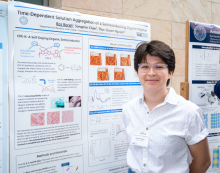
Major:
University:
Mentor(s):
Faculty Sponsor(s):
Faculty Sponsor's Department(s):
Project Title:
Project Description:
Inorganic semiconductors, namely silicon, are the basis of all modern electronics. However, their rigidity, bio-incompatibility, and the relatively high voltage they require to operate have lead researchers to develop a wide variety of organic semiconducting polymers. Poly[2,6-(4,4-bis-potassium butanylsulfonate-4H-cyclopenta-[2,1-b;3,4-b′]-dithiophene) -alt-4,7-(2,1,3-benzothiadiazole)] (PCPDTBTSO3K, or CPE-K), is unique in this class of materials for its combination of desirable traits, including being biocompatible, water-soluble, and self-doping. Generally, conductive polymers are initially neutral and have to be “doped” in complicated chemical processes to introduce free charge carriers. CPE-K generates these free charge carriers by being dissolved in water, and the level of doping can be tuned by changing the pH of the solvent. Additionally, organic electrochemical transistors (OECTs) that use CPE-K can operate in dual modes, switching between accumulation and depletion mode just by changing the gate voltage. Development of the many possible device applications of this material will rely on high conductivity films. One of the main characteristics that determines film conductivity is morphology, or the organization of the polymer chains. Intramolecular interactions between CPE-K chains in solution may cause them to aggregate over time, changing the morphology and conductivity of the material. This study investigates how the age of CPE-K solutions impacts the morphological, optical, electrical properties of resulting films. The surface morphology of the films was probed using Atomic Force Microscopy, the optical properties and doping level with UV-Vis spectroscopy, and the conductivity with I/V characterization. Ultimately, no aggregation was visible in the AFM results on a micron scale. However, the films made from fresh solution had the highest doping level and conductivity, and films made from 16 day old solution, the oldest investigated, had the lowest of both. While further investigation is required to determine what causes these differences, this result suggests that the best practice for researchers is to use a fresh solution of CPE-K when casting films of this highly unique and versatile material.
